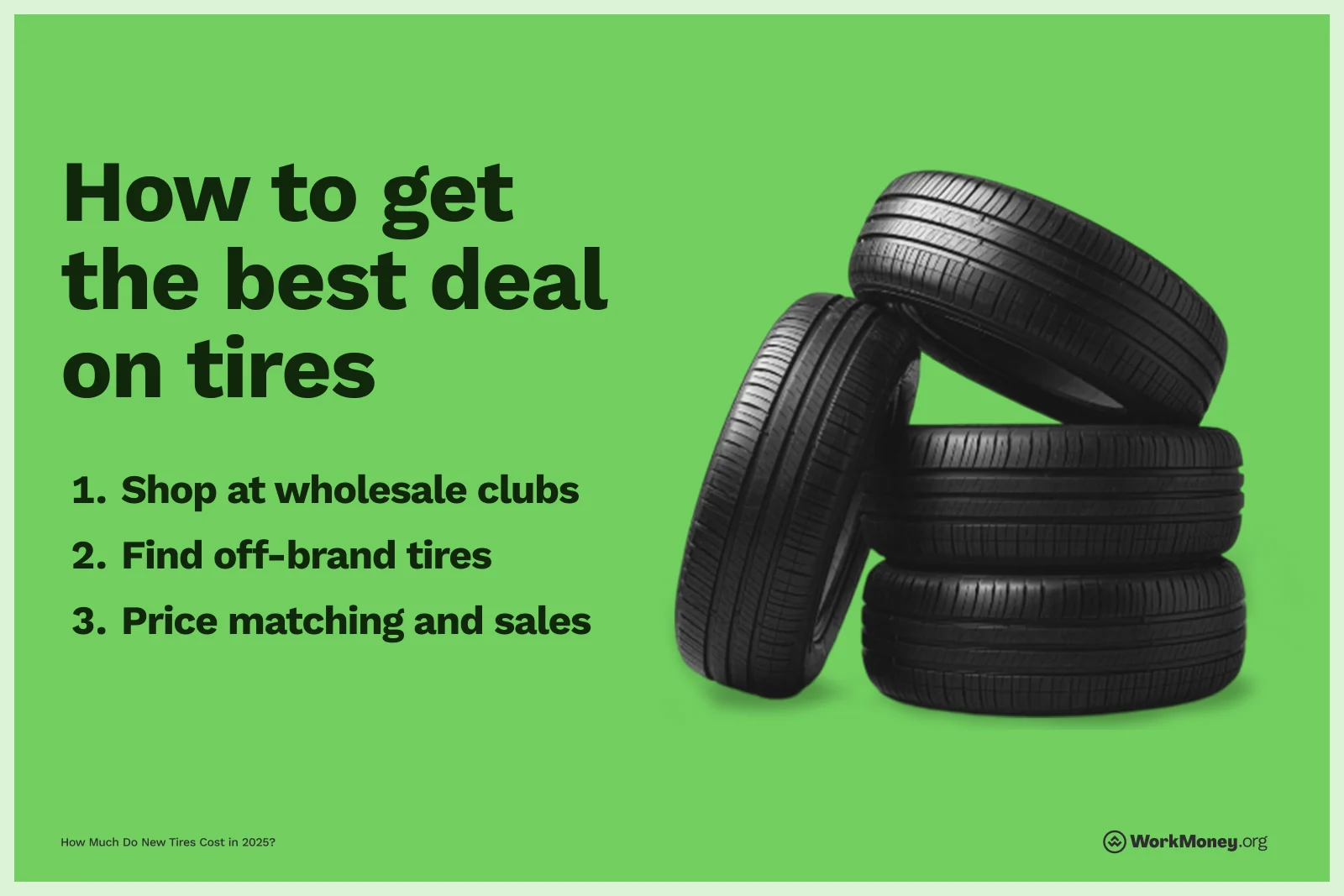How Much Do New Tires Cost in 2025?
2025 tire prices explained: what you’ll spend, ways to save, and smart discounts

Your car’s tires are the only thing between you and the road underneath, so caring for them is crucial to keeping your vehicle safe on the streets.
But tires aren’t cheap. Costs vary widely based on where you live, the type of tires you’re getting, how you’re getting them installed, and the quality of tires. J.D. Power estimates that you can find tires for as low as $100 each, but expect to pay closer to $200 per tire. It’s even more for performance tires. Your car impacts the types of tires you can (and can’t) get, so what works for some vehicles may not work for yours.
If you want to learn how much you’ll spend on new tires this year, WorkMoney shows you how to price them out and what to expect from your tire-buying experience.

How Much Do New Tires Cost?
Tire costs have dramatically risen in the last few years, regardless of quality and type. A year ago, Consumer Reports said drivers paid an average of $223 per new tire. In 2023, ProPublica found that tire costs have increased more than 21% in the last two years — more than twice the inflation rate.
The cost of new tires depends on a few different factors, including:
Wheel size and your vehicle
Your tires’ intended use
Where you buy your tires from and who is doing the installation
The quality of the tires (new or used)
With so many different circumstances, the cost of new tires is different for everyone, ranging from roughly $100 to $1,000 per tire or more.
While you can buy used tires, we’ll focus solely on the cost of new tires for this guide.
What’s causing tire prices to go up?
Like all goods, the cost of making tires has gone up and it’s just one factor of owning a car. However, tire costs have increased more than the inflation rate because of supply chain limitations and the general cost of raw materials.
Tariffs also play a part in the increase in tire costs. In March, President Trump announced 25% tariffs on auto and auto parts coming into the U.S. Since then, tariffs have been on and off again for several countries and imports.
Over 63% of tires sold in the U.S. last year were imported. Now, those countries are getting hit with massive tariffs. Thailand — one of the main countries the U.S. imports tires from — is now subjected to a19 37% tariff. Indonesia is facing19 32% and Vietnam will see a 20 47% rate. Others, too, will see a massive increase.
Tariffs can be harmful to consumers. When companies have to pay a higher price for goods to make their products, they can sometimes pass that extra cost back onto the consumer.
How long do new tires last?
The life of tires lasts anywhere from 35,000 to 75,000 miles or 5 to 6 years, depending on how much you drive, how you drive, and the tire brand. Consumer Reports found that some vehicle tires can last upwards of 85,000 miles. Even if you don’t drive that much, you should replace your tires at least every 10 years.
What to look for when buying new tires
Everyone’s vehicle impacts the type of tires they’ll get. Compact cars need smaller tires compared to SUVs and trucks. Where you live and the road conditions also impact your tire purchase. Winter tires have a firm grip and last through freezing temperatures, while all-terrain truck tires are best for heavy-duty trucks that are good for paved or snowy roads, off-roading, and other uses.
There are nearly 11,000 tire-related car accidents annually, so staying proactive about tire shopping can help you even if you don’t need new ones right away. Here’s what to look for:
Size: Make sure your tires fit your car. Read the numbers on your tire’s sidewall. The first letter is the type (“p” is for performance, for example). The first number is the tire width in millimeters. The next number is the ratio of the sidewall as a percentage. The next letter is the construction and the numbers after that are the wheel rim diameter in inches. Consumer Reports has a good preparation guide.
Load and speed: The load index on each tire is the maximum weight each tire can hold. Typical cars range from 75 to 100. When it comes to speed, look at the final letter on the tire wall. All-season tires might have T, H, or V — and all of those letters have different maximum speeds allowed.
Mileage warranty: Manufacturer warranties usually expire after six years or when you hit the mileage warranty — which varies by manufacturer — whichever comes first.
Brand and cost: Different brands charge different amounts, not only if you buy them directly from the manufacturer or through a tire shop. If you’re buying from a retailer, compare the cost of different brands. Ask your shop what the difference is, what they recommend, and if they are running any specials or deals.
Extra fees: Pay close attention to the labor cost, including installation, disposal, and alignment fees.
Your tire shop may charge a disposal or recycling fee for your tires. Once your tires are off your car, shops get rid of them on your behalf, whether by recycling them or dropping off old tires at municipal drop-offs.
How to make new tires last
The more you care for your tires while you have them, the sooner you’ll know if it’s time to replace them. Check your tires every month or so. You’ll see how worn they’ve gotten and be able to estimate how soon you need to replace them.
Start tracking deals and comparison shop, even if you’re a few months from replacing your tires. You’re more likely to pay less when you’ve had time to do your research than when you need a new set. If you need to replace your tires right away, you may not find as many low-cost options.
Get regular wheel rotations and alignments as part of your car maintenance so the entire tire gets even wear, about every 6,000 to 8,000 miles. Check that your tires are properly inflated. If your tire is over-inflated, you’ll notice a lot more wear in the middle of the tire. Under-inflation will cause the outer sides to show more wear, and even potentially reduce the fuel efficiency of your car.
How to get the best deal on tires
Tires can be a pricey purchase, but there are some ways you can pay less than full price.
The Bottom Line
The cost of new tires can get expensive, especially if you aren’t expecting to pay such a large and unexpected bill. Do your research to make smart shopping decisions when it comes time to buy new tires.
About the Author

Dori Zinn
Dori Zinn is a longtime personal finance journalist with nearly 20 years of experience in digital media. Her work has been featured in the New York Times, Wall Street Journal, CBS News, Yahoo, CNN, USA Today, and more. She loves helping folks learn about money. If she isn’t writing, she’s reading, baking, or watching football.
